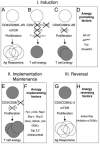mTOR at the crossroads of T cell proliferation and tolerance
- PMID: 17383196
- PMCID: PMC1995654
- DOI: 10.1016/j.smim.2007.02.008
mTOR at the crossroads of T cell proliferation and tolerance
Abstract
Several events control the activation, proliferation, and the continued Ag responsiveness of naïve and memory T lymphocytes. Here we review the individual contributions of TCR, CD28, and IL-2-driven signaling to T cell proliferation and anergy avoidance. The role of mTOR as a rheostat capable of integrating extracellular, plasma membrane-associated, and intracellular signals with relevance to T cell priming and tolerance is discussed.
Figures


References
-
- Itano AA, Jenkins MK. Antigen presentation to naive CD4 T cells in the lymph node. Nat Immunol. 2003;4(8):733–739. - PubMed
-
- Viola A, Lanzavecchia A. T cell activation determined by T cell receptor number and tunable thresholds. Science. 1996;273:104–106. - PubMed
-
- Monks CR, Freiberg BA, et al. Three-dimensional segregation of supramolecular activation clusters in T cells. Nature. 1998;395(6697):82–86. - PubMed
-
- Grakoui A, Bromley SK, et al. The immunological synapse: a molecular machine controlling T cell activation. Science. 1999;285(5425):221–227. - PubMed
-
- Mempel TR, Henrickson SE, Von Andrian UH. T-cell priming by dendritic cells in lymph nodes occurs in three distinct phases. Nature. 2004;427(6970):154–159. - PubMed
Publication types
MeSH terms
Substances
Grants and funding
LinkOut - more resources
Full Text Sources
Miscellaneous

